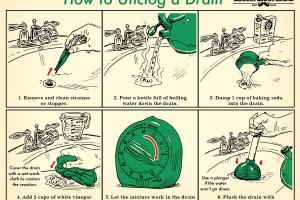Ultimate Guide: How to Unclog a Drain with Proven Techniques

-
Quick Links:
- Introduction
- Understanding Drain Clogs
- Common Causes of Clogs
- Tools You Need
- Step-by-Step Methods
- Preventing Future Clogs
- When to Call a Professional
- Case Studies
- Expert Insights
- FAQs
Introduction
Clogged drains are not just an inconvenience; they can lead to more significant plumbing problems if not addressed promptly. This comprehensive guide will walk you through effective methods to unclog drains, understand the causes of clogs, and prevent future issues.
Understanding Drain Clogs
Drain clogs occur when materials accumulate in the pipes, preventing water from flowing freely. Understanding how clogs form is essential for effective resolution.
Types of Clogs
- Partial Clogs: Water drains slowly, indicating a build-up.
- Complete Clogs: Water does not drain at all, indicating severe blockage.
Common Causes of Clogs
Knowing the common causes can help you prevent clogs in the first place. Here are a few significant culprits:
- Hair: A leading cause of bathroom sink and shower clogs.
- Grease: Often found in kitchen sinks, where oil and fat accumulate.
- Food Debris: Leftover food particles can block grease traps.
- Soap Scum: Soap residue can create a hard layer in pipes.
- Foreign Objects: Items like toys or sanitary products can cause abrupt clogs.
Tools You Need
Before you start unclogging a drain, gather the necessary tools:
- Plunger
- Drain snake
- Pail or bucket
- Vinegar and baking soda
- Boiling water
- Protective gloves
- Flashlight
Step-by-Step Methods
Here’s a detailed guide on how to unclog a drain effectively:
Method 1: Using a Plunger
Plungers are very effective for minor clogs. Here’s how to use one:
- Ensure there’s enough water in the sink or tub to cover the plunger's cup.
- Place the plunger over the drain and create a tight seal.
- Push down and pull up vigorously for 15-20 seconds.
- Check if the water drains; repeat if necessary.
Method 2: Drain Snake
For tougher clogs, a drain snake can be highly effective:
- Insert the snake into the drain until you feel resistance.
- Rotate the snake to break up the clog.
- Pull the snake out, along with any debris.
- Run hot water to flush the drain.
Method 3: Baking Soda and Vinegar
This natural method is great for minor clogs:
- Pour a pot of boiling water down the drain.
- Add half a cup of baking soda followed by half a cup of vinegar.
- Cover the drain and let it sit for about 30 minutes.
- Flush with more boiling water.
Method 4: Professional Drain Cleaner
Sometimes, chemical cleaners can do the trick:
- Follow the instructions on the product carefully.
- Use protective gloves and eyewear.
- Pour the solution into the drain and wait as directed.
- Flush with water afterward.
Preventing Future Clogs
Taking preventive measures can save you from future headaches:
- Install drain screens to catch hair and debris.
- Avoid pouring grease down the sink.
- Regularly flush your drains with hot water.
- Be cautious about what goes down the toilet.
When to Call a Professional
If the clog persists despite your efforts, it may be time to call a plumber. Signs that you may need professional help include:
- Multiple drains are clogged.
- Backed-up sewage.
- Persistent foul odors.
- Water pooling around your fixtures.
Case Studies
Let’s look at some real-world examples of successful unclogging strategies:
Case Study 1: The Hair Clog
A homeowner faced recurrent slow draining in their shower. After using a drain snake, they discovered a significant hairball, which once removed, resolved the issue.
Case Study 2: The Kitchen Sink
A kitchen sink was always backing up. The homeowner used the baking soda and vinegar method, which successfully removed grease build-up, allowing for normal water flow.
Expert Insights
We consulted plumbing experts on the best practices for unclogging drains:
"Regular maintenance is key to preventing clogs. Homeowners should be proactive, using methods like baking soda and vinegar monthly." - Jane Doe, Plumbing Expert
FAQs
1. How often should I clean my drains?
Regular cleaning is recommended every few months, especially for high-usage areas like kitchens and bathrooms.
2. Can I use chemical drain cleaners?
Yes, but use them sparingly, as they can damage pipes over time.
3. What if my sink is still clogged after trying these methods?
If the clog persists, it’s advisable to consult a professional plumber.
4. How can I tell if I have a severe clog?
Signs include multiple drains backing up and unusual smells.
5. Are there eco-friendly ways to unclog drains?
Yes, using baking soda and vinegar is an effective and eco-friendly method.
6. What should I do if my toilet is clogged?
Use a plunger first. If that doesn’t work, consider a toilet auger or seek professional help.
7. Is it safe to pour boiling water down my drain?
Yes, boiling water can help dissolve grease and soap scum, but avoid it if you have PVC pipes.
8. Can hair really cause serious drainage issues?
Absolutely, hair is one of the most common causes of drain clogs, especially in bathrooms.
9. How do I know if I need to replace my pipes?
If clogs are frequent and persistent, it may indicate more extensive plumbing issues requiring a pipe replacement.
10. What’s the best way to maintain my plumbing system?
Regularly clean drains, avoid flushing inappropriate items, and schedule professional inspections.